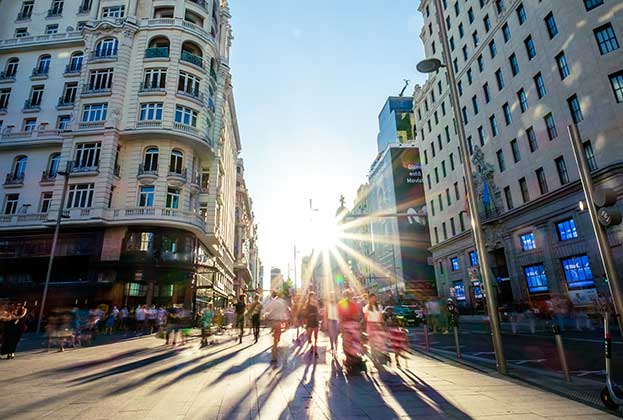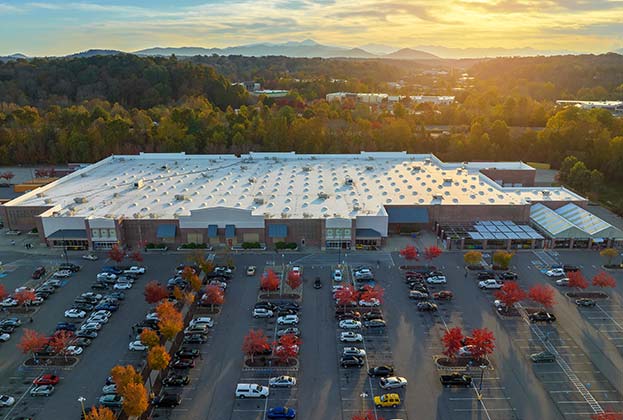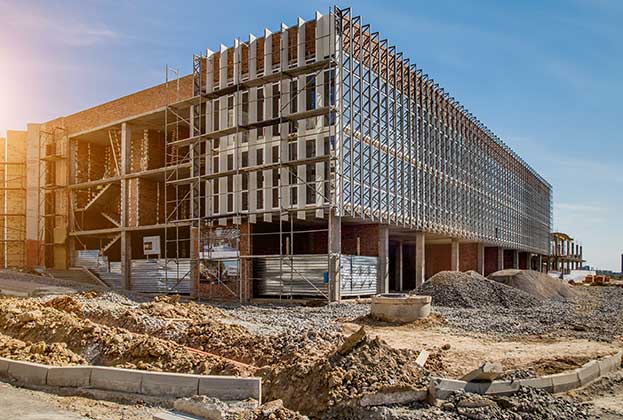Retail investment activity remains relatively resilient and accounts for 17% of total European investment volumes, its largest share since 2016
European retail investments over the first nine months of the year totalled €17.7bn, which was 34% below the five-year average for the period. Whilst volumes were down, activity fared better than other European asset classes; multifamily and office investment over the same period was down -57% and -53%, respectively, against their five-year average. Nearly all countries saw retail volumes down against their five-year average bar Ireland (+69%), the Czech Republic (+54%) and the UK (+13%). As a result of robust activity in the UK, the core markets (UK, Germany and France), captured 71% of this retail activity.
The relatively shallower declines in volumes against other segments meant retail accounted for 17% of total European investment volumes, its largest share since 2016. Compared to the past five-year average, retail volumes declined in nearly all countries except Ireland (+69%), the Czech Republic (+54%) and the UK (+13%).
Why has investment proved to be relatively more resilient?
It’s a combination of factors. Higher yields, particularly in light of higher debt costs, and weaker investor confidence in other asset classes have all come into play.
The sector had already seen strong repricing over the past five years (+150 bps on average across Europe), meaning it had become highly attractive to investors seeking yield. This appeal has been further intensified in the current high financing cost environment, with pockets of liquidity emerging. These include assets offering defensive qualities, divestments from investors looking to raise capital and secondary assets with active asset management, redevelopment, or repurposing angles. Investment volumes have also proved to be relatively more resilient in response to investors' growing diversification strategies and, more recently, weaker confidence in the office sector, particularly in light of its much tighter, or even negative, spread to debt costs.
However, banks and lenders remain cautious about the sector, with a reduced appetite to participate in potentially high-risk transactions. This is reflected in the decline in the number of large, high-leverage deals that once fuelled market growth and were relatively common in the retail sector. We have seen a number of large portfolios across Europe fail to attract buyers due to lenders' reluctance to finance these substantial transactions. Collaborative efforts have emerged as a prudent strategy for adapting to these evolving dynamics. In some countries, financial institutions and buyers are increasingly opting for joint venture arrangements to mitigate the associated risks in these sizable deals.

Acquisitions by occupiers accounting for a larger share
One notable emerging trend of the last 12 months has been the increasing number of retailers opting to purchase the buildings they rent. They accounted for more than 10.3% of total retail investment. This is an increase on their 6.7% share recorded for the same period in 2022 and significantly up on the 1–2% share seen over the preceding five years.
The most active in this group have been the supermarkets. The likes of Sainsbury’s, Aldi, Lidl, Tesco, Coop, and Edeka, sitting on fairly major cash reserves, are capitalising on the downward pressure on capital values. This approach offers retailers greater independence from rental dependencies: a prudent move for both retailers’ stability and long-term profitability.
Robust investor appetite for retail parks and grocery stores
Unsurprisingly, considering the strength of its occupational market, retail parks have been the most resilient part of the retail investment market, recording the lowest annual decline in investment volumes (-26%).
Strong activity was recorded in Italy, thanks to a few portfolio deals, including the joint acquisition by Polis Fondi and LeadCrest Capital Partners of Technomat properties (five properties) for €70bn. There has also been strong activity in CEE countries, notably Austria, Czech Republic and Poland. That said, most of the retail park investment activity seen to date in 2023 was concentrated in the UK, a reflection of the fact that it is a more mature asset class in that market. This meant the UK accounted for 45% of European retail park investment volumes.
Grocery store investment, including supermarkets and hypermarkets, remained relatively unchanged, accounting for approximately 19% of all year-to-date retail investment volumes. Strong activity was recorded in the UK, mainly due to two large occupier acquisitions by Sainsbury’s in January and March for €960 million and €867 million, respectively.
The more subdued activity in the grocery market in 2023 is a reflection of a lack of opportunities rather than a lack of investor appetite, which is very focused on assets occupied by discount and value-orientated brands. Big US REITs such as LCN and Realty are notably very active in that space, particularly across the larger lot sizes. At the smaller end of the spectrum, there is a much wider investor pool, which has helped to generate downward pressure on prime yields.
Luxury high-street opportunities drive high-street investment
Overall, investors' appetite for luxury high streets is somehow mitigated by the fact that there were not enough price corrections. However, high-street investments accounted for 28% of the total retail volume transacted in the first nine months of 2023, in line with the five-year average of 27% but up on the 19% share recorded last year. This relative resilience has been driven by a small number of trophy assets signed in Paris, London and key German cities, including the Louis Vuitton Flagship on 101 Champs-Élysées bought by LVMH from Gecina for €770m. As evidenced in this deal, and similar to that seen in the grocery market, luxury brands have become increasingly acquisitive both as a way to ensure occupational security and reduce exposure to future rental increases but also as a means to deploy capital reserves.
Shopping centre investment has been most exposed to rising debt costs
Despite a slight rebound in shopping centre investment activity during the first half of the year, volumes contracted in the third quarter, meaning that year-to-date volumes as of September were down by nearly 49% year-on-year. Despite this decline, shopping centre investment still accounted for a sizeable share of total volumes at 27%, albeit below its historical five-year average share of 33%.
France grabbed the largest market share of shopping centre investment (33%). Notable French transactions include the acquisition by Ingka group (IKEA) of the 'Italy portfolio', two shopping centres based in the Paris 13th district from Hammerson for €550m. Passy Plaza in Paris 16th district was bought by AEW Ciloger from Generali RE Investment BV for €130m, and a five-factory outlet portfolio (Marque Avenue) was bought by Mata Capital for €200bn.
Generally, shopping centre deals take longer to close due to asset-level complexity and the need to finalise business plans, which, in many cases, have a number of moving parts. In March, Generali and ECE completed the acquisition of the Pep shopping centre in Munich, a deal that was initially agreed upon in late 2022. Apart from the super prime assets, shopping centres generally attract value-add investors seeking opportunities to lease or repurpose. Factory outlet centres, which are a strongly performing subsector and offer transparency on tenant trade, remain on the investor radar. However, these types of investment opportunities are relatively rare.
Upward pressure on yields continues, albeit the pace of softening is slowing
While the acceleration in debt costs in the latter part of 2022 and into early 2023 generated significant upward pressure on prime retail yields, this has been less pronounced than in other sectors where the starting yield was much keener. Since Q2 2022, for example, prime industrial yields have softened by 101 bps to average 5.00%, with office yields out by 116 bps to 4.80%. In contrast, prime retail yields across Europe have softened by an average of 71 bps over the same period to reach 5.30%.
On average, prime residential prices remain 20% above 2021 levels and 41% above pre-pandemic prices
Lydia Brissy, Director, European Research
There are also some early signs that yields are starting to stabilise. September 2022 saw the largest single outward shift in yields, with European retail reporting a quarterly softening of 20 bps on a median basis. European Industrial yields over that same period softened by 31 bps. Since then, we have seen consistent quarterly increases in yields, albeit the rate of this decompression has slowed, with Q2 2023 average retail yields moving out by 11 bps quarter-on-quarter, down on the 14 bps softening reported the previous two quarters. The latest quarter did see a small acceleration in decompression to 15 bps, but we are of the view that this will be a relatively isolated occurrence considering expectations that the current rate-rising cycle has peaked.
In Q3 2023, the European average prime retail warehouse yield stood at 5.9%, marking a 59 bps increase compared to the same period last year. The European average prime shopping centre yield was at 6.1%, reflecting an annual increase of 49 bps. Luxury high street yields were at 4.2% on average across Europe, 42 bps up on the same quarter last year and mass-market high street yields moved out by 53 bps annually to 5.1% in Q3 2023.
Going forward, with the deteriorating economic sentiment steering investors towards super-prime assets and restraining investment opportunities, we expect further yield expansion across Europe until mid-next year, yet at a slower pace than that recorded over the past nine months.
Read the other articles within European Retail Market below
.jpg)




.jpg)

